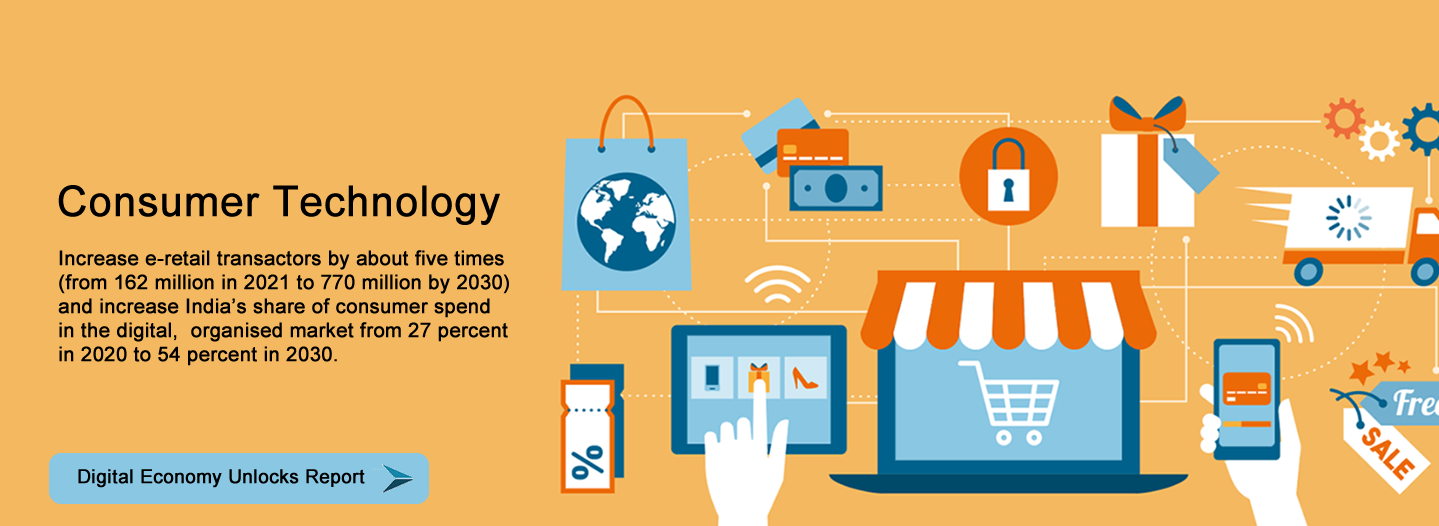
India's Consumer Technology Endowments

 Growing consuming class
Growing consuming class  Strong public digital infrastructure
Strong public digital infrastructure Increasing smartphone penetration
Increasing smartphone penetration
 |
From 0% in 2021 to
>90% % age of population with 5G cellular connectivity |
 |
From ~50% in 2021 to
70%+ Internet users by 2030 |
 |
From ~28% in 2021 to
54% Share of digital and organized market in overall consumer spend |
 |
From 30% in 2020 to
~55% Share of digital + organized markets in 2030 |
 |
From 26% (162 M) in 2021 to
~70% (770M) E-retail transactors in 2030 |
 |
10x Growth in daily digital transactions by 2030
|
India could set up “datasets of national importance” (e.g., healthcare, grain value chain, land records, weather data, etc.) and enable the industry to use them by enriching data on the marketplace, hosting open-source solutions and AI models, and running AI models or bigdata analysis using computing infrastructure.
Key actors: Industry players and startups, in collaboration with the central government
Various industry stakeholders could collaborate to raise India’s profile on innovation by hosting conferences, industry meetings, and roadshows at a global scale (like CES, SXSW and London’s Global IoT Technology Expo). They could also seek government's help to develop two or three domestic success stories across cloud, AI, IoT and cybersecurity as World Economic Forum lighthouse projects.
Key actors: Consortia of companies (consumer tech, software, etc.), in collaboration with industry bodies and the central government
India Inc. could use the India stack and emerging technologies to develop innovative business models and create new solutions. For example, companies could create solutions to enable small businesses to integrate with ONDC and personalize the customer experience, build 'Farm to Fork’ business models, and enable ubiquitous (remote) healthcare and personalized pre-emptive care.
Key actors: Companies across sectors
Telecom companies could leverage unique Indian 5G standards (designed to facilitate 5G coverage for rural areas) to develop device connectivity solutions such as modules optimized for emerging countries with lower density of network infrastructure and indigenous 5G stack.
Key actors: Telecom companies, in collaboration with software players and government
India could work towards a full-scale commercial launch of UPI Lite (an on-device wallet system that could enable small offline transactions). This could serve populations in rural areas who struggle with limited internet connectivity. India could also co-develop a framework to enhance security and utilize distributed ledger technology and emerging tech like IoT to bring innovation to existing systems.
Key actors: Banking institutions, fintech companies, and software players, in collaboration with NPCI
India Inc. could develop and harmonize key industry standards and governance rules related to data management, classification, privacy, etc., cybersecurity, blockchain, quantum computing, etc. User feedback could be incorporated through public consultations in such programs.
Key actors: Industry bodies (e.g., FICCI, NASSCOM), with support from relevant government bodies (e.g., Digital India Corporation, IT Ministry)
India Inc. could collaborate with state governments to develop courses / training modules for small businesses on digitizing business processes such as demand forecasting, procure-2-pay, inventory planning, cataloguing, supply chain, etc. It could also offer solutions / advisory services for MSMEs to leverage digital opportunities.
Small businesses can integrate with Open Network for Digital Commerce (ONDC) or Government e-Marketplace (GeM) to access new markets and suppliers, and leverage digital solutions to enhance customer experience and optimise operations.
Key actors: Companies (including digital natives, SaaS, etc.), in collaboration with the state government
The central government could ease the process of testing and piloting new technologies by enabling regulatory sandboxes. This would accelerate the application of new technologies such as cryptocurrency, quantum computing and 5G/6G. It will also be important to encourage self-regulation of industry for efficient consumer redressal and compliance.
Key actors: MeiTY, RBI, SEBI and TRAI
State governments could implement the National Education Policy, 2020, to supplement school curricula with digital literacy modules and strengthen learning outcomes through simulation/gamified projects on basic IT skills (e.g., web development, basic coding, and data analytics). It could also design courses for adults, with emphasis on use of India stack and technology for services such as banking, healthcare and agriculture.
Key actors: State government, in collaboration with sector experts, companies and industry bodies
The government could provide risk capital or non-term grants to top 50-100 institutions doing research in STEM modules such as AI/ML, robotics and biotech to build India's R&D ecosystem. It could also offer scholarships and launch dedicated hiring programs to promote post-graduates and PhD students in STEM.
Key actors: Department of Higher Education, Ministry of Education
The central government could sign international reciprocal agreements with ASEAN, Japan, Korea, and South America for work visas instead of immigration visas for easier flow of talent and business.
Key actors: Ministry of External Affairs